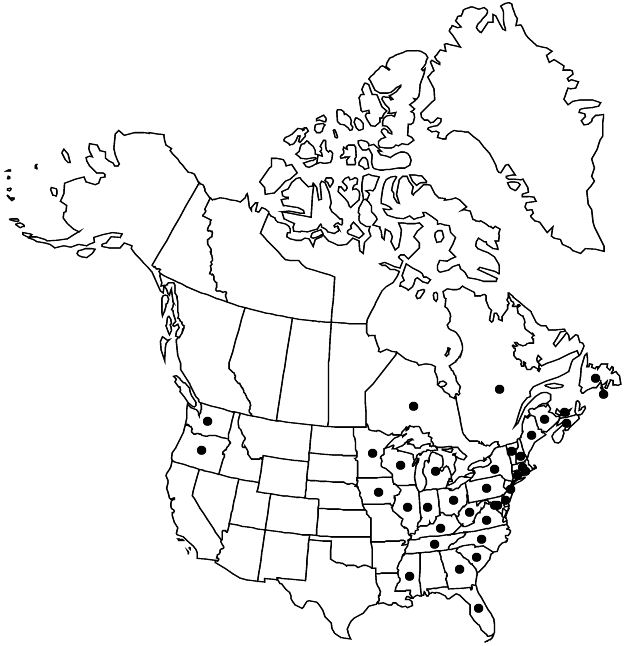Hypericum canadense
Sp. Pl. 2: 785. 1753.
Herbs annual or perennial, erect, basal branches relatively few or none, usually with strict, ascending branches from distal nodes, 0.3–7.5 dm. Stems: internodes 4-angled. Leaves erect or spreading, sessile or subsessile; blade linear to oblanceolate-linear or (proximal) oblanceolate to obovate, 6–55 × 0.5–5.5 mm, papery to membranous, margins plane, apex rounded, basal or near-basal veins 1–3(–5), midrib with 1–4 pairs of branches. Inflorescences corymbiform to cylindric, usually diffuse, 1–35-flowered, branching mostly dichasial. Flowers 5–6 mm diam.; sepals linear-lanceolate to lanceolate, equal, 2.5–4.5 × 0.8–1 mm, margins sometimes ciliate, not setulose-ciliate, apex acute to acuminate; petals golden yellow, sometimes red-veined, narrowly obovate to elliptic, 2.5–4 mm; stamens 12–25, obscurely 3–5-fascicled; styles 0.5–0.8 mm; stigmas broadly capitate. Capsules narrowly conic to conic-cylindric, 4–6 × 1.5–3 mm, broadest proximal to middle. Seeds 0.5–0.7 mm; testa finely linear-scalariform. 2n = 16.
Phenology: Flowering summer (Jun–Sep).
Habitat: Fens, marshes, depressions, lake and pond margins
Elevation: 0–500 m
Distribution

St. Pierre and Miquelon, N.B., Nfld. and Labr. (Nfld.), N.S., Ont., P.E.I., Que., Conn., Del., D.C., Fla., Ga., Ill., Ind., Iowa, Ky., Maine, Md., Mass., Mich., Minn., Miss., N.H., N.J., N.Y., N.C., Ohio, Oreg., Pa., R.I., S.C., Tenn., Vt., Va., Wash., W.Va., Wis., introduced in Europe (Ireland, The Netherlands).
Discussion
Hypericum canadense is closely related to H. majus; it hybridizes with that species and with H. mutilum, producing intermediate forms. Hypericum ×dissimulatum E. P. Bicknell appears to comprise a continuous series of hybrids between H. canadense and
H. mutilum or H. boreale such that it is not always possible to say which of these species is involved. Hypericum ×dissimulatum has been recorded from New Brunswick, Newfoundland, Nova Scotia, Ontario, and Quebec and from Connecticut, Maine, Maryland, Massachusetts, New Jersey, New York, North Carolina, Pennsylvania, Rhode Island, and Virginia.
J. Rousseau reduced Hypericum canadense var. minimum to a form; it does not seem to merit any recognition.
Selected References
None.
